Burhinidae – Thick-knees & Stone Curlews
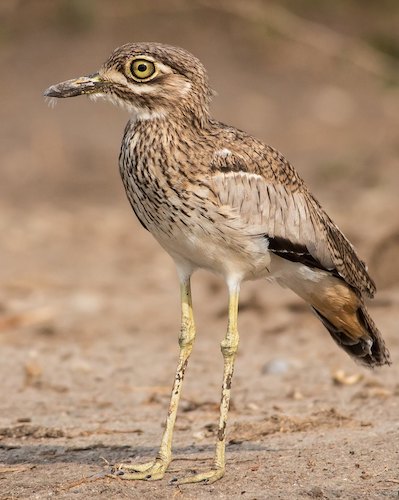
The Burhinidae (Thick-knees & Stone Curlews) family is related to the waders, but sufficiently distinctive to merit its own family. The order Charadriiformes also includes Pluvianellidae (Magellanic Plover), Chionidae (Sheathbills), Pluvianidae (Egyptian Plover), Recurvirostridae (Stilts & Avocets), Haematopodidae (Oystercatchers), Ibidorhynchidae (Ibisbill), Charadriidae (Plovers & Lapwings), Pedionomidae (Plains Wanderer), Thinocoridae (Seedsnipes), Rostratulidae (Painted Snipe), Jacanidae (Jacanas), Scolopacidae (Sandpipers), Turnicidae (Buttonquails), Dromadidae (Crab-Plover), Glareolidae (Coursers & Pratincoles), Stercorariidae (Skuas), Alcidae (Auks) and Laridae (Gulls, Terns & Skimmers).
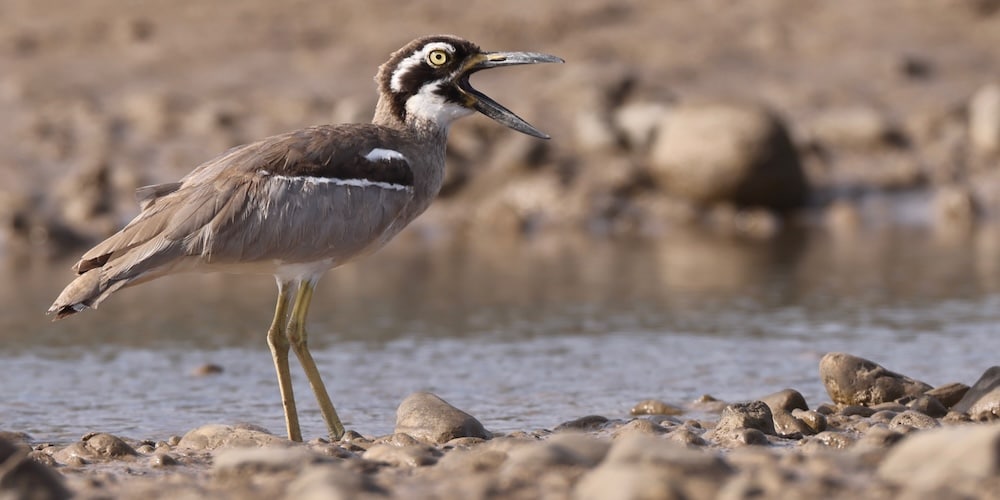
Beach Stone-curlew Esacus magnirostris – ©Bird-Photo-Tours ASIA
The Burhinidae or stone-curlews, also known as dikkops or thick-knees, consist of ten species found throughout the tropical and temperate parts of the world, with two species found in Australia. Despite the group being classified as Charadriiformes like waders, most species have a preference for arid or semi-arid habitats.
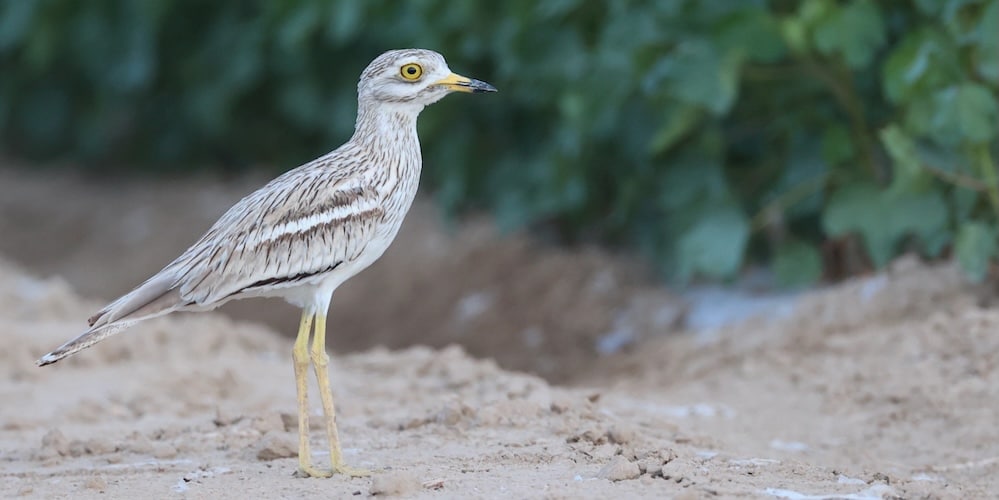
Eurasian Stone-curlew Burhinus oedicnemus – ©Bird-Photo-Tours ASIA
Named for the stony ground on which they live, one of the most striking features of the stone-curlews is their large, piercing yellow eyes, an adaptation to their crepuscular lifestyle – they are most active at dawn, dusk and through the night. Their mottled brown and sandy plumage is ideally suited as camouflage on open, sandy ground, where their nest is often little more than a scrape in the ground.
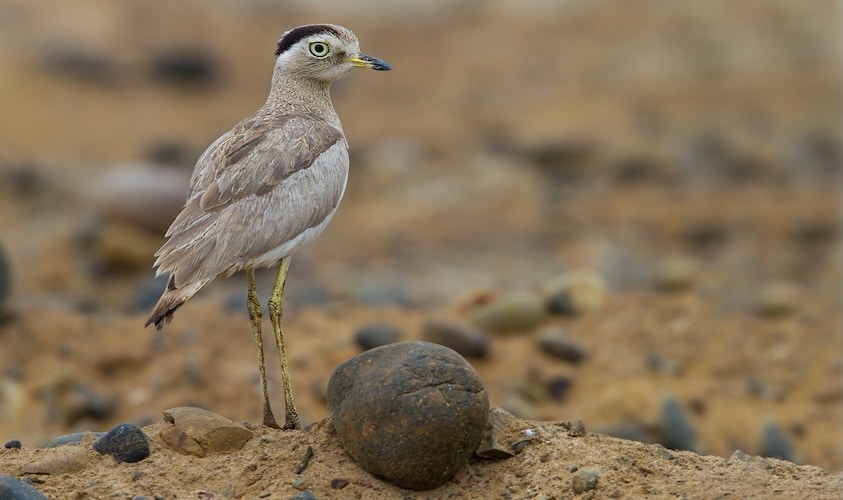
Peruvian Thick-knee Hesperoburhinus superciliaris – ©Dubi Shapiro
They are medium to large birds with strong black or yellow black bills, large yellow eyes, which can give them a reptilian appearance, and cryptic plumage. The names thick-knee and stone-curlew are both in common use, the preference among authorities for one term or the other varying from year to year. The term stone-curlew owes its origin to the broad similarities with true curlews (which are not closely related). They get their alternative name of thick-knee from the swollen ‘knee’ joint (which, as in all birds, is actually more akin to an ankle joint) on their long yellow or greenish legs. It apparently originated with a name coined in 1776 for Burhinus oedicnemus, the Eurasian stone-curlew. Obviously, the ankle (heel) and the knee were anatomically confused.
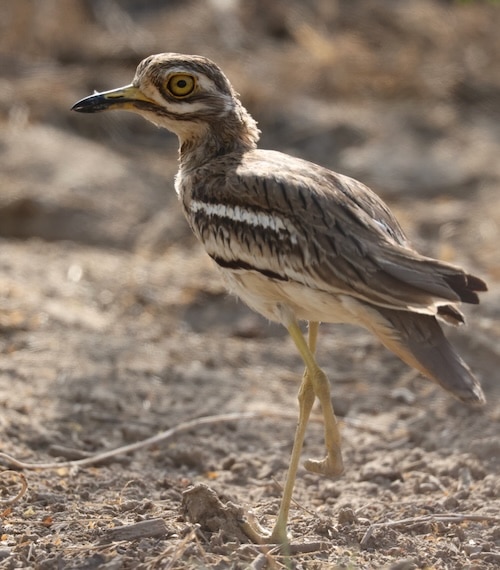
Indian Stone-curlew Burhinus indicus – ©Dubi Shapiro
They are largely nocturnal, particularly when singing their loud wailing songs, which are reminiscent of true curlews, which can be heard across a wide area of countryside. By contrast, most spend the daylight hours quietly in the shade of a bush when available. Their long wings are not as pointed as those of most charadriiforms, and when opened, they expose bold stripes of black and white or spots of white that contrast sharply with their generally camouflaged plumage.
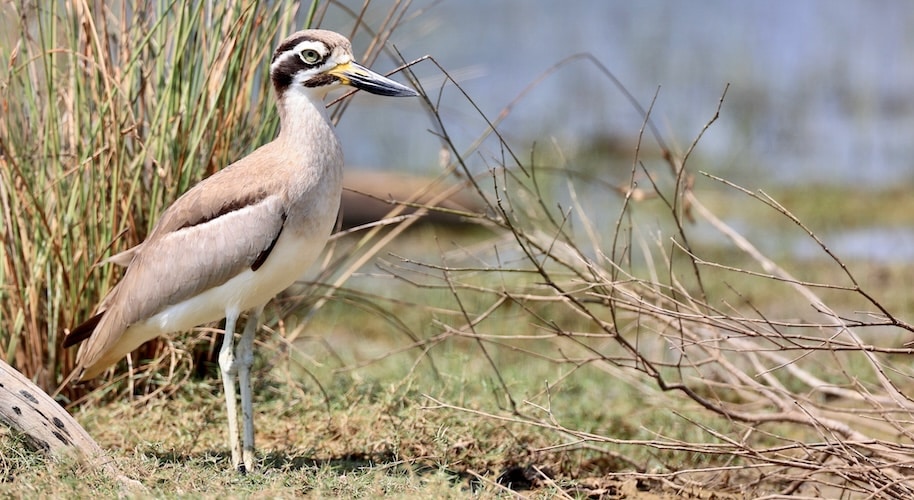
Great Stone-curlew Esacus recurvirostris – ©Bird-Photo-Tours ASIA
The diet consists mainly of insects and other invertebrates such as desert snails. Larger species will also take lizards and even small mammals. Most species are sedentary, but the Eurasian Stone-curlew is a summer migrant in the temperate European part of its range, wintering in Africa.
-
Number of bird species: 10
(As at August 2025)
According to the recently (2025) unified AviList, there are just ten species of Thick-knees or Stone Curlews (sometimes Dikkop in southern Africa) in three genera in the family Burhinidae, which is part of the Charadriiformes order. They are:
Peruvian Thick-knee Hesperoburhinus superciliaris
Double-striped Thick-knee Hesperoburhinus bistriatus
Beach Stone-curlew Esacus magnirostris
Great Stone-curlew Esacus recurvirostris
Bush Stone-curlew Burhinus grallarius
Spotted Thick-knee Burhinus capensis
Water Thick-knee Burhinus vermiculatus
Senegal Thick-knee Burhinus senegalensis
Indian Stone-curlew Burhinus indicus
Eurasian Stone-curlew Burhinus oedicnemus
-
The Norfolk Plover - A Study of the Stone-Curlew
| By Chris Knights | Wild Breckland Books | 2023 | Hardback | 215 pages, colour photos | ISBN: 9781399955690 Buy this book from NHBS.com -
Waders of Europe, Asia & North America
| By Stephen Message & Don Taylor | Christopher Helm 2005 | Paperback | 224 pages, 80 plates with colour illustrations | ISBN: 9780713652901 Buy this book from NHBS.com
-
Burhinidae
Family AccountThe thick-knees are large terrestrial “shorebirds” that can often be found far from water... -
Burhinidae
Family AccountThey get their alternative name of thick-knee from the swollen 'knee' joint (which, as in all birds, is actually more akin to an ankle joint) on their long...
Given that this is a rather small family with just 10 species in three genera, Fatbirder provides active links below to all the Burhinidae species.
-
Beach Stone-curlew Esacus magnirostris
Species AccountThe beach stone-curlew (Esacus magnirostris) also known as beach thick-knee is a large, ground-dwelling bird that occurs in Australasia, the islands of South-east Asia. At 55 cm (22 in) and 1 kg (2.2 lb), it is one of the world's largest shorebirds. At a mean of 1,032 g (2.275 lb) in males and 1,000 g (2.2 lb) in females, it the heaviest living member of the Charadriiformes outside of the gull and skua families. -
Beach Stone-curlew Esacus magnirostris
Species AccountThe Beach Stone-Curlew is a very large thick-set wader. Adults have a large head, massive uptilted bill, hunched profile, stout legs and thick 'knees' (actually ankles). The upper body is predominately grey-brown with distinctive black and white patterning on the face, shoulder and secondary wings. -
Beach Stone-curlew Esacus magnirostris
Species AccountUnsustainable overfishing and human disturbance (such as leisure activities, collecting shellfish) have been a huge problem for this species due to loss of habitat... -
Beach Stone-curlew Esacus magnirostris
Species AccountSound archive and distribution map. -
Bush Stone-curlew Burhinus grallarius
Species AccountThe bush stone-curlew or bush thick-knee (Burhinus grallarius, obsolete name Burhinus magnirostris) is a large (55–60 cm wingspan),[2] ground-dwelling bird endemic to Australia. Although it looks rather like a wader and is related to the oystercatchers, avocets and plovers, it is a terrestrial predator filling an ecological niche similar to that of the roadrunners of North America. -
Bush Stone-curlew Burhinus grallarius
Species AccountThe Bush Stone-curlew, or Bush Thick-knee, is a large, slim, mainly nocturnal, ground-dwelling bird. It is mostly grey-brown above, streaked with black and rufous. -
Bush Stone-curlew Burhinus grallarius
Species AccountBush Thick-knee Burhinus grallarius has most recently been assessed for The IUCN Red List of Threatened Species in 2016. Burhinus grallarius is listed as Least Concern. -
Bush Stone-curlew Burhinus grallarius
Species AccountSound archive and distribution map. -
Double-striped Thick-knee Hesperoburhinus bistriatus
Species AccountFull species account... -
Double-striped Thick-knee Hesperoburhinus bistriatus
Species AccountLarge and bizarre shorebird of lowland dry grassland and savannas, usually found in pairs or small groups. Active mainly at night... -
Double-striped Thick-knee Hesperoburhinus bistriatus
Species AccountThe double-striped thick-knee (Burhinus bistriatus) is a stone-curlew, a group of waders in the family Burhinidae. It is a resident breeder in Central and South America from southern Mexico south to Colombia, Venezuela and northern Brazil. It also occurs on Hispaniola and some of the Venezuelan islands, and is a very rare vagrant to Trinidad, Curaçao and the USA... -
Double-striped Thick-knee Hesperoburhinus bistriatus
Species AccountSound archive and distribution map. -
Eurasian Stone-curlew Burhinus oedicnemus
Species AccountThe Eurasian stone curlew, Eurasian thick-knee, or simply stone-curlew (Burhinus oedicnemus) is a northern species of the Burhinidae (stone-curlew) bird family. -
Eurasian Stone-curlew Burhinus oedicnemus
Species AccountEurasian Thick-knee Burhinus oedicnemus has most recently been assessed for The IUCN Red List of Threatened Species in 2018. Burhinus oedicnemus is listed as Least Concern. -
Eurasian Stone-curlew Burhinus oedicnemus
Species AccountSound archive and distribution map. -
Great Stone-curlew Esacus recurvirostris
Species AccountSound archive and distribution map. -
Great Stone-curlew Esacus recurvirostris
Species AccountGreat Thick-knee Esacus recurvirostris has most recently been assessed for The IUCN Red List of Threatened Species in 2017. Esacus recurvirostris is listed as Near Threatened under criteria A3cd. -
Great Stone-curlew Esacus recurvirostris
Species AccountThe great stone-curlew or great thick-knee (Esacus recurvirostris) is a large wader which is a resident breeder in tropical southern Asia from India, Pakistan, Sri Lanka, Bangladesh[2] into South-east Asia. -
Indian Stone-curlew Burhinus indicus
Species AccountLarge, bizarre-looking shorebird with streaky brown plumage and piercing yellow eyes. Black-and-white wing pattern visible in flight. -
Indian Stone-curlew Burhinus indicus
Species AccountThe Indian stone-curlew or Indian thick-knee (Burhinus indicus) is a species of bird in the family Burhinidae. It was formerly included as a subspecies of the Eurasian stone-curlew. This species is found in the plains of India, Pakistan, Nepal and Sri Lanka. They have large eyes and are brown with streaks and pale marks making it hard to spot against the background of soils and rocks. Mostly active in the dark, they produce calls similar to the true curlews, giving them their names. -
Indian Stone-curlew Burhinus indicus
Species AccountSound archive and distribution map. -
Peruvian Thick-knee Hesperoburhinus superciliaris
Species AccountBirdLife species profile... -
Peruvian Thick-knee Hesperoburhinus superciliaris
Species AccountUsually found as pairs or small groups. Spends the day resting, often sitting on the ground in the shade. Prefers to run, rather than fly when alarmed. -
Peruvian Thick-knee Hesperoburhinus superciliaris
Species AccountThe Peruvian thick-knee (Burhinus superciliaris) is a species of bird in the family Burhinidae. It is found in Chile, Ecuador, and Peru. Its natural habitats are subtropical or tropical dry shrubland, subtropical or tropical seasonally wet or flooded lowland grassland, and pastureland. It is a ground-dwelling bird and feeds on insects and small animals. -
Peruvian Thick-knee Hesperoburhinus superciliaris
Species AccountSound archive and distribution map. -
Senegal Thick-knee Burhinus senegalensis
Species AccountSound archive and distribution map. -
Senegal Thick-knee Burhinus senegalensis
Species AccountThe Senegal thick-knee (Burhinus senegalensis) is a stone-curlew, a group of waders in the family Burhinidae. -
Senegal Thick-knee Burhinus senegalensis
Species AccountSenegal Thick-knee Burhinus senegalensis has most recently been assessed for The IUCN Red List of Threatened Species in 2016. Burhinus senegalensis is listed as Least Concern. -
Spotted Thick-knee Burhinus capensis
Species AccountBirdLife species profile... -
Spotted Thick-knee Burhinus capensis
Species AccountThe spotted thick-knee (Burhinus capensis) also known as the spotted dikkop or Cape thick-knee, is a wader in the family Burhinidae. It is native to tropical regions of central and southern Africa. -
Spotted Thick-knee Burhinus capensis
Species AccountSpotted Thick-knee Burhinus capensis has most recently been assessed for The IUCN Red List of Threatened Species in 2016. Burhinus capensis is listed as Least Concern. -
Spotted Thick-knee Burhinus capensis
Species AccountSound archive and distribution map. -
Water Thick-knee Burhinus vermiculatus
Species AccountSound archive and distribution map. -
Water Thick-knee Burhinus vermiculatus
Species AccountThe water thick-knee (Burhinus vermiculatus), or water dikkop is a species of bird in the family Burhinidae. It is found in Angola, Botswana, Burkina Faso, Burundi, Cameroon, Central African Republic, Republic of the Congo, Democratic Republic of the Congo, Ivory Coast, Ethiopia, Gabon, Ghana, Kenya, Liberia, Malawi, Mozambique, Namibia, Niger, Nigeria, Rwanda, Senegal, Somalia, South Africa, Swaziland, Tanzania, Uganda, Zambia, and Zimbabwe. -
Water Thick-knee Burhinus vermiculatus
Species AccountWater Thick-knee Burhinus vermiculatus has most recently been assessed for The IUCN Red List of Threatened Species in 2016. Burhinus vermiculatus is listed as Least Concern.
-
The New Shorebirds Handbook Project
BlogThis is a blog of The New Shorebirds Handbook Project which aims to bring together the current knowledge on shorebird science, conservation and a little bit more. By following the blog, readers could insight into the progress and important milestones of the project and the recent news on the world of waders and a bit more of us, the authors….
